-
United States -
United Kingdom -
India -
France -
Deutschland -
Italia -
日本 -
대한민국 -
中国 -
台灣
-
-
产品组合
查看所有产品Ansys致力于通过向学生提供免费的仿真工程软件来助力他们获得成功。
-
ANSYS BLOG
January 4, 2024
Simulation Stretches the Boundaries of Extreme Mobility
Tune in to episode five of “Driven by Simulation” and see how Polaris and Potential Motors use Ansys software to rethink recreational vehicle design.
For some riders, where the pavement ends, the adventure begins. Off-roading often stretches vehicle capabilities in new, uncharted directions. Just hop in, then set your sights on any horizon and go — up and over ruts, rocks, dips, bumps, and graded roads, or fording through streams.
Today, enthusiasm for the sport is growing, as on-road adrenaline junkies shift gears to go off the beaten path. In 2020, the off-road vehicle (ORV) market amassed more than $12.3 billion globally. Adventure tourism is also attracting a more affluent fan base to the sport, specifically overlanding (exploring the back country in well-equipped ORV), which is on a growth trajectory that began at $586 billion in 2019 and will increase to $1.63 billion by 2026.
During the fifth episode of our online docuseries “Driven by Simulation,” we visit global powersports leader Polaris and automotive technology start-up Potential Motors to see how they’re going wide-open on ORV performance with a little help from Ansys.
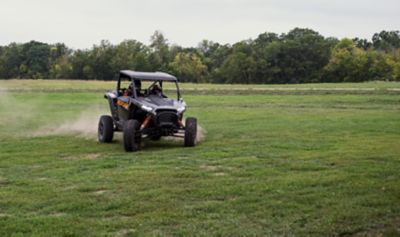
Simulation is Polaris’ North Star for Off-Road Innovation
Think outside, live the riding experience, and work to make it better. It’s a vision that’s fueled rider-driven innovation at Polaris since 1954 — so much so, that everyone working at the shop rides the product to understand its performance and the challenges of the trail ahead. RZR XP, Polaris’ bestselling sport side-by-side off-road vehicle exemplifies this spirit, along with the high level of rider-driven innovation you’d expect from a global industry leader in powersports.
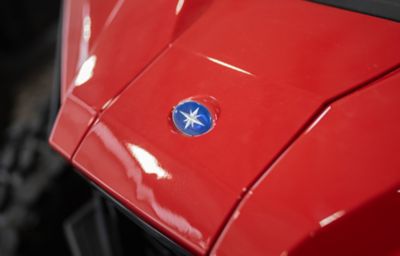
David Elia, Director, Product Planning - Recreation at Polaris, says his team gets a lot of inspiration from customers, which is a big reason for RZR XP’s success. Polaris considers this feedback, then acts on it in anticipation of market trends to remain competitive. A recent refresh, for example, focused on delivering more all-day comfort and capability in a more rugged design. To do this, in part, required an increase in chassis strength with an assist from Ansys.
“Our chassis is about 25% stronger, or stiffer than it was,” says Elia. “With simulation we were able to tell from the inputs what we needed out of the chassis. We were able to make a completely boltless, fully welded chassis that was much stronger.”
To arrive at the RZR XP’s new 114 horsepower, Pro Star Gen 2 parallel twin engine design, Polaris turned to Ansys computational fluid dynamics software to understand air flow in and out of the engine. Zeroing in on fluid dynamics enabled the team to optimize the head, combustion chamber, intake and exhaust tracks to build in more power. From there, the clutch and driveline components were also updated for added durability.
Polaris also used simulation to ensure the engine could consistently perform as it was intended — through rock crawl areas, dunes, mud, and deep woods for hours off-road in harsh conditions.

David Elia, Director of Product Planning - Recreation, Polaris
“Designing an engine cooling system that survives all of these conditions is not a trivial thing,” says Pratik Chandan, Senior Engineer Manager at Polaris. “One of the issues we have is that we need to learn physical interactions of the complex systems together in the virtual environment and that’s what simulation tools like Ansys helps us do.”
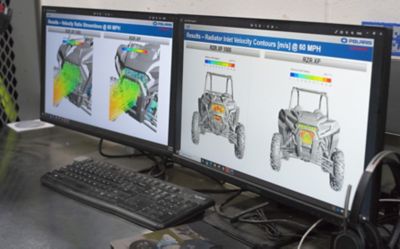
Engine cooling is just one of the engineering features Polaris simulated with Ansys solutions.
Potential Motors Takes on the Toughest Terrain with Simulation
Off-roading takes skill, as there is a lot to consider out on the trail. Understanding a vehicle’s approach, departure, and breakover angles; knowing when to punch it or when to let up; or choosing the right time to air down your tires can mean the difference between getting through or getting stuck.

Sam Poirier, CEO of Potential Motors, explains the concept of proactive vehicle systems using cameras and sensors.
Potential Motors, a member of the Ansys Startup Program, is facilitating development of all-electric, off-road vehicles that can see, understand, and proactively prepare for the toughest terrain ahead for you, enabled by software, artificial intelligence (AI), and a suite of sensors. The ultimate goal in all of this is to enable any driver, regardless of skill level, to take on the most challenging terrain with confidence.
The automotive tech company has put in a considerable amount of work into building a platform that reflects its vision for how a software-defined vehicle (SDV) might look in an electric vehicle application, stretching beyond the limits of what is available in the market today, then testing that vision.
“We spend a lot of time in simulations trying to figure out, you know everything from what is the lidar going to see to how is the chassis going to react — so this vehicle itself is our own platform,” says Sam Poirier, Co-founder and CEO of Potential Motors. “We built it from scratch, because we really wanted a software-defined vehicle for off-road, and surprisingly enough there isn’t one available for us to just use.”
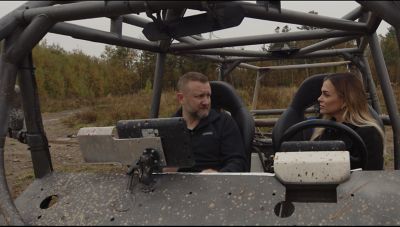
Bill Lamey, CTO of Potential Motors, discusses remote sensing technology with Driven by Simulation host, Miss Emma Walsh.
Software already supports the advanced driver-assistance systems (ADAS) we are used to seeing in our vehicles. In the future, however, our vehicles will primarily be defined by software. Otherwise known as SDVs, they will have the ability to shape our driving experiences through connectivity, AI, automation, and personalization.
In developing his SDV platform, Poirier also realized he was solving a fundamental problem related to off-road efficiency that extends beyond the recreational audience to commercial sectors like mining or logging, where conquering environmental conditions is often a prerequisite for daily productivity.
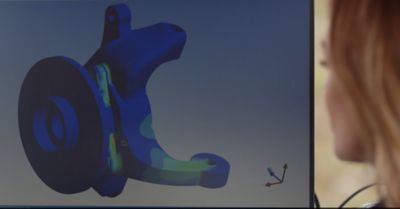
“Without simulation I think we’d have a very hard time building something like this,” says Poirier. “Especially, you know we’re a small team, we’re a start up here in Canada, and with limited resources you have to do stuff efficiently. Simulation means that you can do things efficiently. You can do a lot more with a small team.”
Off the Beaten Path
"Driven by Simulation," the future of mobility is definitely going places. Be sure to watch the latest installment of our online docuseries as we head off in search of adventure with Polaris and Potential Motors.










